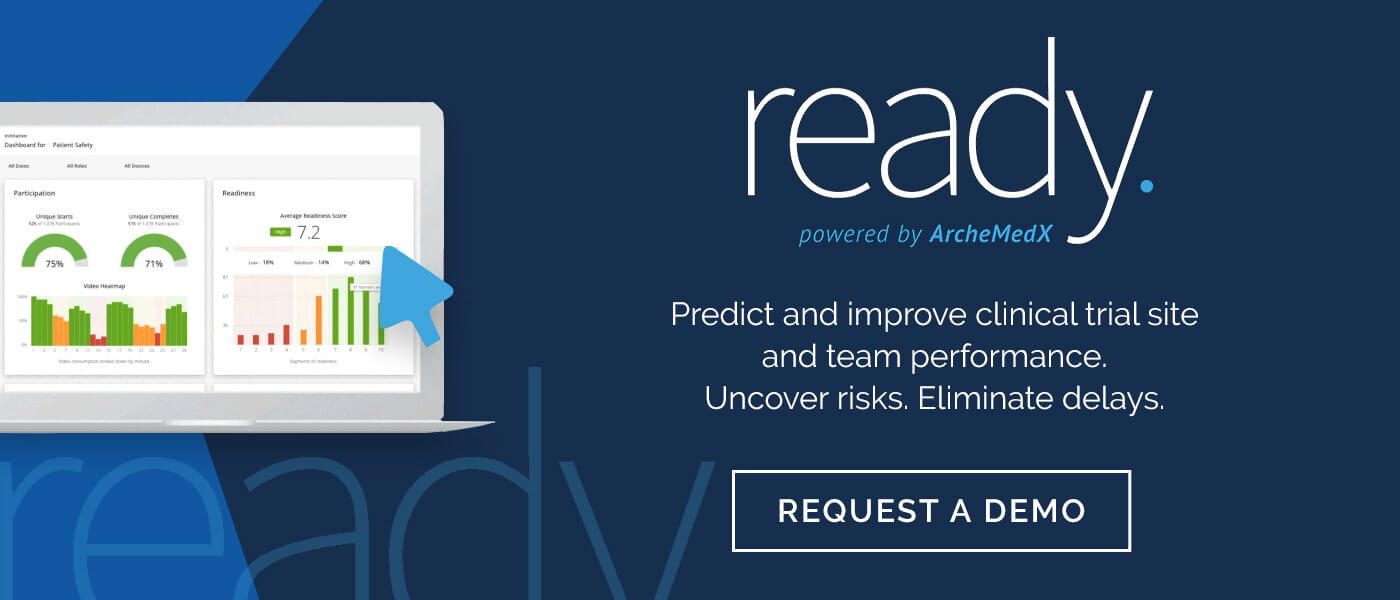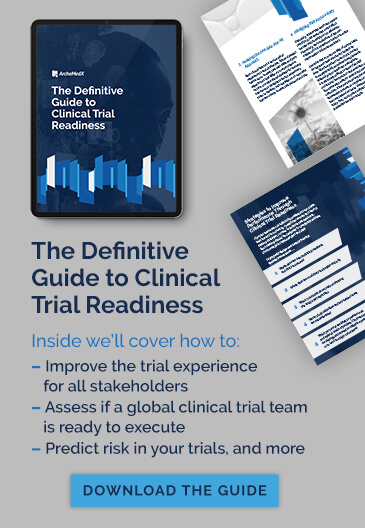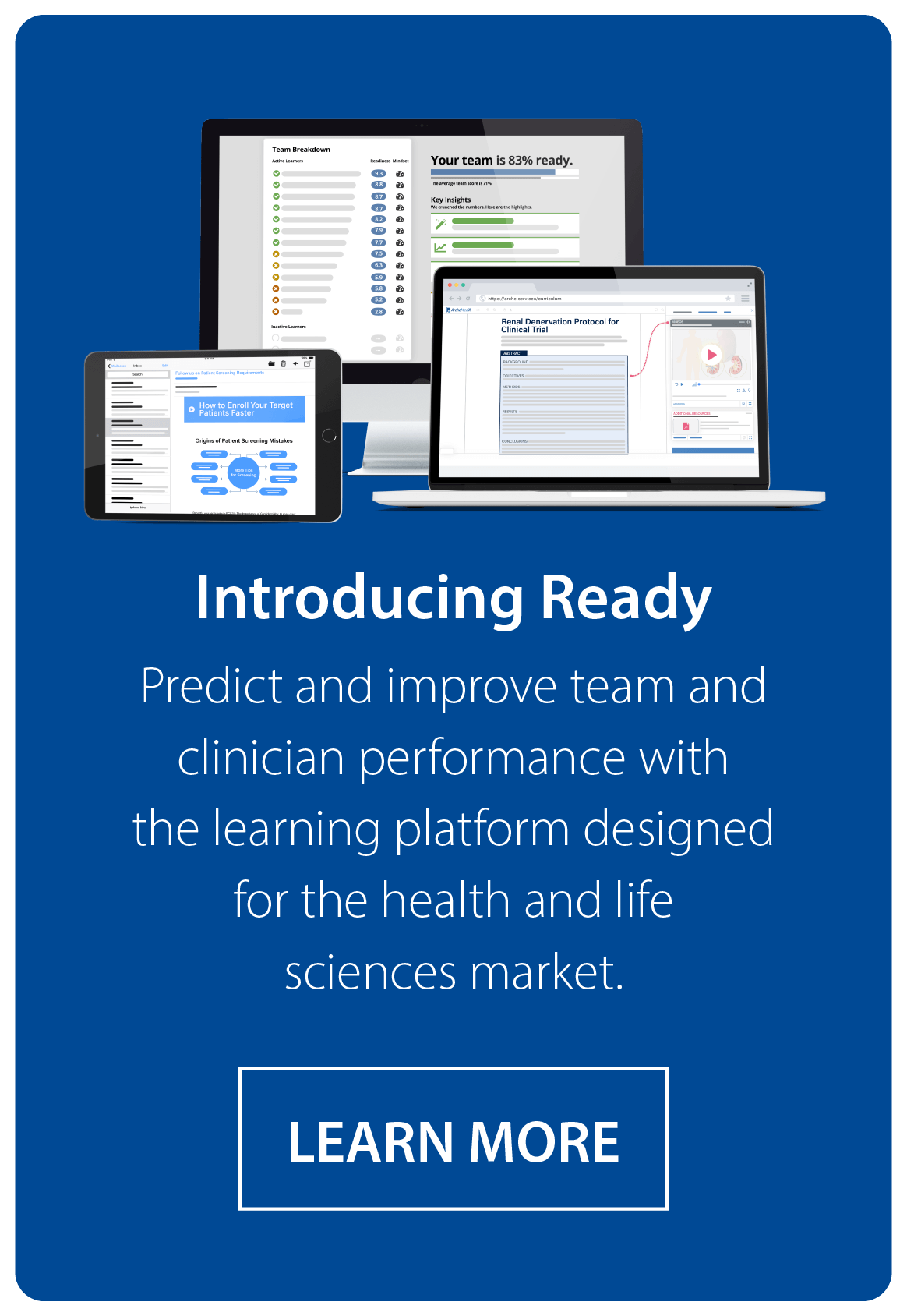It’s impossible to read an industry publication without hearing about virtual clinical trials, decentralized clinical trials, or hybrid trials. Industry leaders and technology companies are touting the advantages and the opportunities to anyone who will listen. You may understand the model, and you may recognize the effort to shift. But do you really know what clinical trial software you need to make these clinical trial designs work? What does it really take?
In this article, we’ll explore the 12 different clinical trial solutions you’ll need, and why you need them.
The clinical trial software you need for virtual, decentralized, and hybrid trials
There are 12 – yes, 12 – solutions you need to conduct the clinical trial itself. This doesn’t include protocol development, the lab equipment, or basic infrastructure. For technology-enabled clinical trials, you will need a solution for:
- Clinical Trial Training Platform (eLearning)
- Electronic Data Capture (EDC)
- Interactive Response Technology (IRT)
- Clinical Trial Management System (CTMS)
- Electronic Trial Master File (eTMF)
- eConsent
- Electronic Clinical Outcome Assessment (eCOA and ePRO)
- Supply Management
- Electronic Health Record Mining
- Televisit Platform
- Patient Engagement
- Virtual Site Monitoring
Wow – that is a long list! So let’s dig in.
Clinical trial software for performing your study
Clinical Trial Training Platform
In a virtual clinical trial, even if only hybrid, you lose the ability to manage onsite training. But that means it’s an opportunity to embrace the flexibility of on-demand learning with a clinical trial training platform.
Decentralized teams may span geographies and time zones. Your stakeholders are no longer a captive audience all located centrally. Now that the team delivering a trial is dispersed, you could easily spend days or weeks trying to deliver various sessions to accommodate all. Instead, choose technology that lets you deploy once, update centrally, and allows staff and team members to participate on-demand.
You have to train your clinical trial team, your investigators, caregivers, and other stakeholders. If you get this wrong, you risk releasing under-prepared trial staff into the field. You also must consider how you can scale your efforts across various groups without adding additional staff.
Fortunately, on-demand clinical trial software enables you to both scale training and reduce risk. Ready is an ideal tool as you work to adopt one of the emerging virtual clinical trial design.
Reframing the PI Meeting
One giant expense and stress point you can cross off your list with a virtual clinical trial is the traditional primary investigator meeting (PI meeting). Especially with dispersed project team members, the expensive, in-person, full-day meeting of the past is even less economical.
However, you can still equip your PIs – and more efficiently, effectively, and conveniently. Make sure you choose a solution that helps you:
- Train directly on your existing clinical trial protocol.
- Augment your content with images, audio recordings, video files and supporting resources and study tools.
- Emphasize the most critical learning objectives, drive attendees to engage at the right moments and around the most relevant content and resources.
- Understand attendees’ engagement and focus – and not just whether they attended.
- Analyze attendees’ knowledge and confidence with the protocol and content you provided.
- Automate follow up on key learning objectives.
Running a virtual site initiation visit (SIV)
Another headache that virtual and decentralized clinical trials eliminate? The site initiation visit (SIV). With the potential for no sites at all, the last thing you want to do is visit with every PI or caregiver individually.
Instead, with the virtual study startup tools available today, you can move this to the fully virtualized list. When you plan how to deliver the activities that make up the historical SIV, make sure you choose a solution that includes:
- On-demand content delivery
- Site and individual progress through your study content
- Data, not a pre-set checklist of tasks, inform and determine how you speed up a PI or staff member, or slow them down.
- Automate follow ups to keep clinicians and staff engaged
Keeping distributed teams engaged
After the study kicks off, your need to equip your caregivers doesn’t end. Nor does the work involved. But you can greatly reduce the effort – and greatly increase the performance – if you select a clinical trial training solution that offers the features we’ve noted above. You can continue to use the same content (or new information like best practices) to keep improving how sites or caregivers perform.
You may need more ideas in making this shift, so check out what clinical trial readiness really means. Learn more in the Definitive Guide to Clinical Trial Readiness.
Electronic Data Capture (EDC)
The next clinical software solution on the list is electronic data capture (EDC). This tool is a critical piece of the clinical trial because it stores the patient data you collect. Traditionally, patient data is first recorded on paper, and later entered into an electronic case report form (eCRF).
However, the more decentralized clinical trials become, the greater the need for centralized collection. Just today, I watched my aging parent’s home health nurse arrive, care for him, then take notes in a well-worn notebook that was small enough to easily misplace.
Home health visits will eventually become a scalable part of technology-enabled clinical trials. Thus, it will be more effective, sustainable, and secure for data to be recorded once. Whether you adopt an off-the-shelf EDC with direct entry or esource capabilities or develop your own process in-house, your EDC platform will provide you features like:
- Designing eCRFs
- Real time validation checks to improve direct data entry
- Interation capabilities
- Exporting and reporting data
Clinical Trial Management System (CTMS)
Some clinical trial sponsors and CROs need a more comprehensive solution for managing clinical trials. Those companies choose to use a Clinical Trial Management System (CTMS), which they may sync with the EDC.
A CTMS is essentially a project management tool, tailored to the needs of clinical operations teams. Traditionally, many clinical trial teams felt that CTMS tools were too complex for their needs. But virtual and decentralized clinical trials have unique circumstances that make data centralization more important.
Make sure you know what problems you’re hoping to solve with a CTMS, so that you select wisely since these systems can be expensive and complex. Some of the feature areas you will see are:
- Contact management – sites & teams
- Document management & eTMF
- Calendar & monitoring
- Clinical trial site activities, contracts, and payments
- Issue management
- Project plan and timeline tracking
- Milestones & tasks
- Workflows
- Visit report authoring & letter generation
- Reporting & analytics
Interactive Response Technology (IRT)
In clinical trials, it’s already common to use a web-based or phone-based tool to allow clinical research sites to interact with your clinical systems. Phone-based versions of IRT have been around at least since the 90s, and in a virtual clinical trial, you’ll definitely need to provide this remote capability.
IRT systems are valuable for site users like PIs and study coordinator, for CRO project team members, sponsor teams, and CRAs, among others.
Look for a tool that can allow these stakeholders to do things like:
- Add and randomize study patients
- Record IP and kit assignments
- Record screen failures and other activities
- Acknowledge receipt of supplies or shipments
- Track shipments and IP availability
You’ll also need the ability for your own project team to access the data inputs and requests, review progress, manage users, and configure details about the study. Your team may include Clinical Project Managers, Clinical Research Associates (Site Monitors), Clinical Trial Assistants, Medical Monitors, Data Managers, Biostatisticians, and others as needed.
Electronic Trial Master File (eTMF)
Like a few of the other clinical trial software in this list, the eTMF (electronic trial master file) has become standard in clinical research. In addition to housing all of the important documentation about your clinical trial, it also serves to provide a clear regulatory overview for agencies.
Therefore, you must make sure your eTMF software includes:
- eTMF process management, workflows, and configuration
- Powerful search, using metadata
- Uploading, indexing, and managing documents
- A full audit trail and access controls
- Electronic signature
- Strong notification functionality
eConsent
As clinical trials become more and more complex, it becomes harder for patients to understand their responsibility. Making informed consent forms more comprehensive doesn’t help, especially if we’re reducing the face-to-face interactions where patients ask questions.
That’s why a digital approach to informed consent is critical. And the features you need should be fairly obvious, since they should make the traditional process more portable:
- A simple electronic signature process, that is fully compliant with US 21 CFR Part 11
- Support for diagrams, images, videos, and screen readers to enable patient comprehension
- Online, on-demand access to the supporting documents for patients post-consent
- An ability for patients to ask questions – and receive answers
However, is this enough to truly inform research subjects? It may not be.
Are your study documents extremely complex? Are you engaging with research-naive sites or patient populations? If so, you should consider adopting a more supportive approach to informing your participant. Add to the above list the need for:
- A way to provide an assessment of understanding during the consent process.
- Support for ongoing engagement with research subjects, to improve the likelihood that they will remain in the study.
Electronic Clinical Outcome Assessment (eCOA)
One of the most critical parts of the actual clinical research process is the intake of patient data. And for any decentralized clinical trial, whether fully virtual or hybrid, you need to find digital methods to collect this data.
Electronic clinical outcome assessment (eCOA) is an emerging set of technologies that enable clinicians, patients, and site staff to enter outcomes directly in a digital format.
Do you have an eCOA solution among your clinical trial software? If not, make sure you look for one that offers:
- Data entry by both web and mobile applications
- Configurable questionnaires
- Encrypted security
- Automated notifications
- Full compliance with regulatory requirements
The last feature on the list may be the most important. If you ensure regulatory compliance, you’ll be safe to use it for any FDA approval research you’re doing without adding burden to your patients.
Many clinical operations leaders find themselves confused when they’re investigating eCOA because of another technology, ePRO.
What is the difference between eCOA and ePRO?
Electronic Patient-Reported Outcomes (ePro) is one type of eCOA. Where an eCOA solution provides outcomes entry data for multiple stakeholders (including patients, clinicians, caregivers, and others), ePRO is specific to patients.
Do we need a separate ePRO solution?
Any eCOA solution you choose should include ePRO capabilities if you will collect patient reported data. As long as it does, you won’t need a separate ePRO solution.
You should only be investigating separate ePRO software if:
- Your eCOA tool is not comprehensive enough to include mobile access
- You won’t use a full eCOA, and will only be accepting patient recorded data digitally.
Combine with eCOA: patient wearable tech
For the collection of biomarker data, you can’t beat wearables like smart watches and wristbands. For one, there’s a low barrier to adoption for patients. Plus, wearable devices optimize data collection with their sensitivity and widely-tested calibration.
Even though wearables are a fairly mature market, they haven’t been broadly adopted in clinical research. Also, in some research-naive patient populations, you may have to introduce the technology and provide it to the patients.
But combining these hardware devices with clinical trial software that can accept their inputs like an eCOA could be a huge boost to your clinical trial. They offer a simple, real-time way to collect data remotely like walking speed, seizure detection, or perspiration, as examples.
Enabling diagnostic and biomarker data collection is a critical step in supporting a virtual clinical trial.
Supply Management
One great need that you must address to accommodate a trial without centralized sites is that of a trackable and traceable supply chain. How do you coordinate the delivery of clinical trial investigational product without a central site? How will you collect specimens from patients?
Even if you’re running a hybrid clinical trial, with some activities at a site and other virtual, you must consider an approach to managing the movement of these items.
You will need a platform or partner that can help you with not only the movement, but the tracking and monitoring of materials. Since you need to know when to replenish supplies, you’ll need help with reordering, maintaining inventory, and related data management. These could include:
- Procuring lab kits
- Delivering and administering IP
- Biological samples
- Home health nurse supplies
- Unused or expired trial materials
Since you will be moving materials across many more locations than a site-based study, consider also that you’ll need support for GPS, real-time tracking, and monitoring on temperature, status, viability, and other factors of care that are specific to biological samples.
Clinical trial software for managing patients virtually
Electronic Health Record Mining or Digital Patient Recruitment
I’d be remiss if I failed to address one of the top concerns for clinical operations leaders today: patient recruitment. Using electronic health records (EHRs) is on the upswing as a method for creating a large enough sample for a clinical trial.
Also available are sources of real world data and patient communities. With a reduced reliance on a set of centralized sites with their own patient populations, you must shift how you attract patients. While this may seem limiting, it actually broadens your ability to tap into under-represented areas and populations. For rare disease research, in particular, having digital recruitment or EHR mining options can be critical.
Televisit Platform
A televisit or telemedicine platform is probably the most important clinical trial software on this list for the patients. Having access to your investigators, and to clinicians, is what enables you to offer a decentralized clinical trial, or possibly a siteless one.
Instead of visiting a hospital or care center, patients can interact with clinicians via videoconference using these tools. Besides enabling a virtual clinical trial, offering consults this way opens up your access to previously under-represented communities of patients.
Many investigators may already provide such a service to their patients. But, if you need to provide infrastructure to some new areas, make sure you fully investigate televisit software that is purpose built for clinical trials.
You can’t get away with just using meeting software, for example. You need to make sure that the telemedicine appointment you recommend or provide is private, secure, and HIPAA-compliant. If you must offer the platform to your investigators, look for a televisit software with features like:
- A simple-to-use experience for patients and clinicians
- Robust scheduling and coordination
- Advanced video communication technology and screen sharing
- Secure and private connectivity
- Communication options for before-and-after care consultations
Patient Engagement
In a decentralized or virtual clinical trial, patients can feel more disconnected from their caregivers. That’s why you must have an approach for patient engagement.
There are emerging solutions for patient engagement across the healthcare industry, but most of them are not specifically tailored for engaging patients in a clinical trial. So what should you do?
You do need an approach, but you may have a clinical trial software already in your toolkit that can help. Look for something that can help you to:
- Simplify distribution of updates and information
- Assess whether patients understand what you and trial staff have shared with them
- Automate reinforcement of critical details
Virtual Site Monitoring
Clinical trial teams cling to the on-site monitoring visit. However, if you’re running a decentralized clinical trial, or a siteless trial, your approach to monitoring clinicians and caregivers will have to change.
Traditional on-site monitoring visits aim to ensure sites are following processes, accurately reporting data, and applying the trial protocol correctly. A move towards virtual clinical trials should actually reduce the effort you must expend to do site monitoring. This is for two reasons:
- Many of the checks that monitors traditionally perform are available in real-time through one of the other clinical trial software solutions on this list
- You will have fewer or perhaps no actual sites to visit and monitor in a virtual or decentralized clinical trial
That said, you still must meet the requirements that the traditional onsite monitoring visit addresses. So what is the path forward?
First, you need to ensure that you successfully implement and actively use some of the clinical trial software already on this list, including:
- eTMF – to assess the consistency of investigative site file documents with the eTMF.
- CTMS – to check for any deviations or adverse events and necessary reporting status.
- eConsent – to ensure each subject has been informed, and given consent.
- Supply management – to ensure drug accountability and storage.
Second, you need to adopt solutions for the remaining objectives of site monitoring. These include:
- Source document verification – to compare source documents with eCRF data.
- Assessing compliance with study product
- Ensuring processes are followed
- Supporting patient engagement and oversight
Clinical trial software needs to support the people and the research
The clinical trial is a complex mix of people, process, and technology. The most flexible of these is the technology, so make sure you choose clinical trial software that can meet the ever-changing needs you have in your research.
There are still a lot of challenges to address as we shift to decentralized, hybrid, or fully virtual clinical trials. Technology has become the cornerstone for most of our research today, and the use of these clinical trial software solutions makes it easier.
If you’re looking for the first clinical trial software tool on the list, a clinical trial training platform, be sure to register for a complimentary demo of Ready by ArcheMedX.





